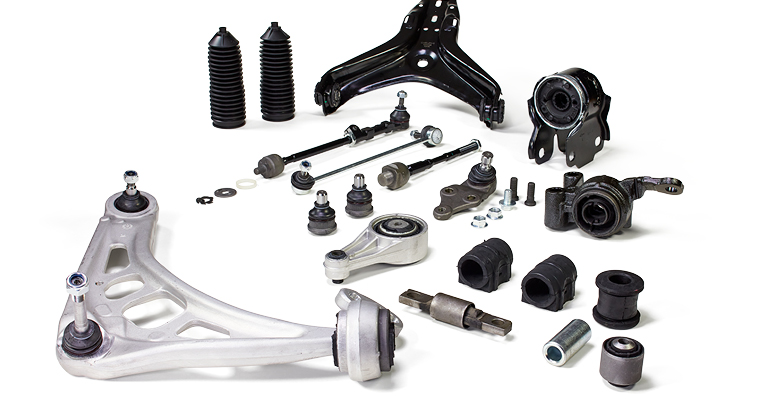Best Practices for Steering & Suspension Repairs
A vehicle's steering and suspension system is an intricate network of linked components designed to work both together and independently to provide a smooth, stable, and safe ride. Since the suspension is typically the first system affected when it comes to road abuse, its components can be the first to wear out or even fail. And while it may seem daunting to try to diagnose steering and suspension problems because of all the components involved, through careful diagnosis and repair you can have your customers back on the road in no time.
Why is it important to check steering and suspension?
Steering and suspension components are designed to tolerate high endurance loading. Despite this, over an extended operating life, they will gradually wear. Worse still, it only takes a small amount of play or looseness in the components to make the whole system noticeably slack and imprecise. Initially, this may simply be annoying, however, over time it may compromise both the vehicle’s ride quality and safety.
What to look out for?
As a safety critical component, it’s advisable to check a vehicles’ steering and suspension system for any potential faults during routine servicing. Additionally, if your customer mentions any of the common symptoms below, it is a good indication of steering and suspension issues:
-
Vehicle continually pulls to one side while driving
-
A steering pull or drift to one side after turning
-
Loose or sloppy steering: it has excessive play and wanders from side to side
-
Excessive steering wheel vibration
-
Steering veers to one side when driving over a bump or during hard acceleration
-
Difficulty in turning the wheel
-
Irregular tyre wear
-
A knocking or clunking sound
Best practice advice
By following some simple best practice advice during diagnosis and repair you can help to minimise vehicle downtime, preventing further costs to your business:
-
Before you start replacing parts, check all of the mounting nuts and bolts to ensure that they are all correctly tightened. It could save you and your customer a lot of time and money.
-
Inspect the vehicle for any visual clues. If possible, check the visible parts such as bushings, ball joints, steering linkages, etc. If you see any damage, cracks, broken boots or if something just doesn’t look right, it may need to be serviced and replaced.
-
For vehicles equipped with power steering, check to see if the fluid reservoir is full. If it isn’t, fill it up, and then check again after a while. If it has gone down again, check under the vehicle for signs of any fluid leakage. Leaks could potentially be in the steering pump, hoses or the steering rack itself.
-
Quickly shake the steering wheel turning it left and right at a small degree (quarter of full circle). There should not be excessive play or knocking noises. If the car has power steering, ensure this is carried out with the engine running.
-
If the car makes noise while turning, it could be the sign of a worn ball joint. If the ball joints are the type with a grease nipple, they are prone to wear if not lubricated properly or after prolonged use. Worn ball joints should be replaced.
-
A suspension system has rubber bushings at the inner end of the control arms, which keeps the wheel in position. When the suspension bushing is worn out, steering problems and abnormal tyre wear may occur. If this is the case the bushings must be replaced.
-
When removing steering components, soak the nuts with penetrating spray in advance in order to help facilitate their removal.
-
Always tool tighten parts to the vehicle manufacturer’s specifications. Never use air or power tools as they could potentially cause component damage.
-
Ensure that you tighten all wheel bolts to the vehicle manufacturer’s torque specifications.
-
Torque components in their loaded position, not wheel-free. This will prevent the components being under additional stress when the vehicle is lowered to the ground.
-
Never re-use fasteners. Steering and suspension systems use nuts with a self-locking feature to ensure they do not become loose due to vibration. Most nut locking features are designed for single use and therefore should not be re-used.
-
It is important to set the steering geometry after replacing any steering or suspension component as the new components will have less play and set the wheels at a slightly different angle. Check all three angles to minimise rolling resistance, friction and tire wear:-
-
Replacing tie rod ends, tie rods or a steering rack will alter the distance between the steering arms which impacts the toe. After the parts have been installed, measure the vehicle’s toe. Adjust the tie rods to set toe within the vehicle manufacturer's specifications.
-
The constant movement of a vehicles’ suspension system can change the geometry of the control arms and struts, and thus the camber. This is not normally adjustable, so if the measurements are noticeably different either side, the tyres, wheels or suspension may be distorted and should be inspected.
-
Caster can affect the vehicles’ steering stability, effort and return. Generally speaking, it should be within 0.5 of a degree, side to side. Any measurement greater than this can cause a drift to one side and will need to be reset.
